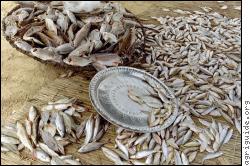ContextFishing practices  Going alongside the coastal areas of West Africa, it is inevitable that you will notice the canoe of artisanal fishermen. For many villages fishing is the only economic activity which can provide decent jobs and continues therefore to attract people looking for a decent living. Fishermen generally gather in a community because of their common interest, which is the main reason of the creation of traditional coastal villages. Quality in regards to presence and health of fishLately, fish presence in coastal Sahel has decreased considerably. That situation combined with overfishing has had a bad impact on the health of the species. Some other species tend to disappear in the fishery of that region because of the industrialization and over-exploitation which have brought about new kinds of infections. Overfishing and stock managementIn order to preserve the marine ecosystem, fishermen must respect certain basic rules. For example, having too much fish in a basket but not knowing how to stock them for future use is counterproductive. Overfishing is one of the major problems in fishing villages which do not have the technology to freeze the unsold production. To respond to the issue of conservation, women have developed techniques of processing it. In Senegal, the most famous technique consists of grilling the fish and then drying it under the sun for at least three days. The result is called “keccax” and can be conserved for three months without any problem. Another technique is known as “gejj” which consists of cleaning the fish, coating it with salt and drying it under the sun for two to three days. As with the “keccax”, the resulting product can be also used three months later. However, the overfishing dilemma does not come from artisanal fishermen, but mostly from industrial vessels which are literally devastating the ecosystem. The damages are numerous and the worst is that these foreign boats are confiscating the fish of the local fishermen. As a consequence, artisanal fishermen are now obliged to fish in the high seas because the coast is no longer able to supply them with enough fish. Fishing strategiesThe industrialization of the fishing sector is causing many damages to the traditional fishermen who find it more and more difficult to supply their customers. However, the government of Senegal is trying to introduce new reforms to the sector of artisanal fishing for its survival and sustainability. To date, the sector has been little regulated, no taxes are being paid, and no permits are required. However, according to a BBC article [http://news.bbc.co.uk/2/hi/business/4182972.stm] (following a four-day conference in Nigeria discussing the matter), the government of Senegal is trying solve part of the problem by introducing a system of taxation. Now, the government is trying to find ways of restricting the ever-growing canoe fleet although any declaration has yet to be made. Nutrition / human healthThe fishery is an important portion of our nutrition. Fish is the most consumed food in Sub-Saharan societies. Its use is linked to its availability, but also to the nutriments it gives to our organism. Fish are an excellent source of high quality protein. They are low in fat, particularly cholesterol and saturated fats. They are rich in calcium, particularly small fish eaten with bones. Canned fish are very rich in calcium due to the fact that during processing they soften up. Additionally, marine fish are good sources of iodine. Being low in sodium they are sufficiently rich in potassium. Pollution absorption and mercury levelsThe factories in the coasts are throwing their waste into the open sea and since the coast is no longer able to supply the market for sufficient fish, fishermen are obliged to go into the high seas to throw their nets. These factories are polluting the water and the fish will serve as vehicle to this waste which is transferred to people through the food chain. Nearly all fish contain traces of mercury from industrial smoke and accumulates in streams and oceans, subsequently being turned into methyl-mercury in the water. This transformation is dangerous to children. Fish absorb the methyl-mercury as they feed in these waters and it builds up in their bodies. It builds up more in some types of fish and shellfish than others, depending on what the fish eat. Pregnant women and fishFor most people, the risk from mercury by eating fish is not a health concern. Yet, some fish contain higher levels of mercury that may harm babies and children who are developing their nervous system. The risks from mercury in fish depends on the amount consumed. That is why some types of fish are to be avoided by pregnant women. Because they contain a high level of mercury, Shark, Swordfish and Tilefish are not advisable to pregnant women. |

